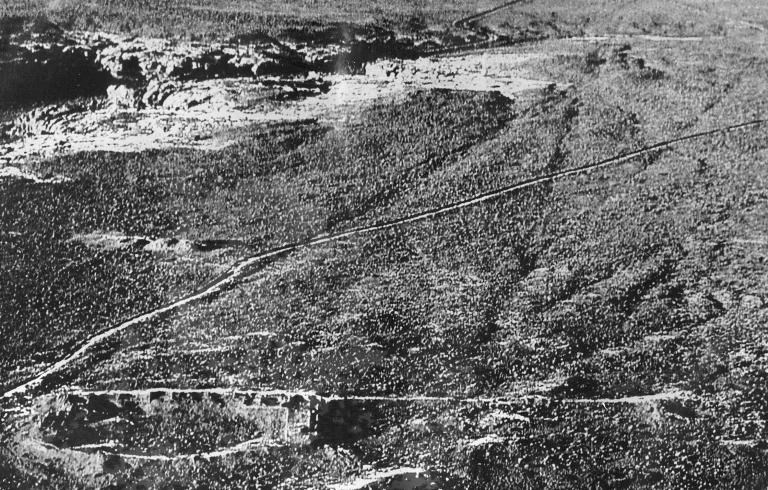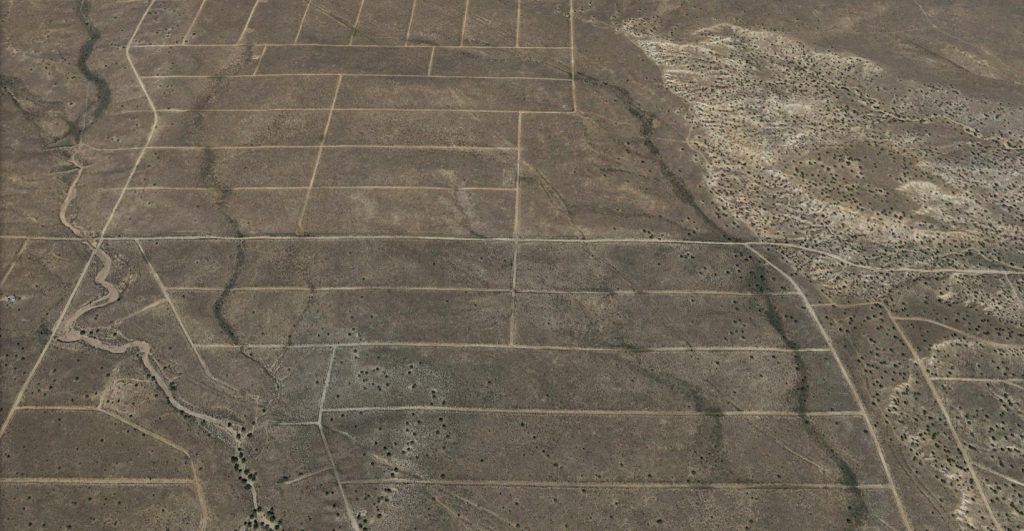A Tale of Two Ruins
I’ll show you a place, high on a desert plain / Where the streets have no name …
—U2, The Joshua Tree, 1987
I recently flew over two mysterious master-planned communities carved into the barren desert of northwestern New Mexico. They are only about 100 miles apart as the crow flies, but they could not be more different. One is ancient, the other modern. One is inspiring, the other melancholy. One is a monument to cooperation and dedication, the other to greed and deception.
Both are thought-provoking examples of the ways people approach development and community-building in an inhospitable climate.
In late September, I was with friends in a six-seat turboprop plane, flying over—and almost through—Chaco Culture National Historical Park, located about 180 miles northwest of Santa Fe. If you’ve never been to this UNESCO World Heritage Site, put it on your bucket list of must-see places. Chaco Canyon contains at least seven “great houses”—stunningly beautiful, massive apartment buildings, one up to four stories tall in one part, and consisting of about 650 rooms.
Ancestors of modern Puebloans built these wonderful structures between 850 and 1150. Surrounded by steep cliffs and breathtaking buttes, Chaco Canyon is enigmatic yet predictable, mysterious yet understandable, and romantic yet empirical—at least up to a point. We still do not know exactly why people built these dwellings in a desolate canyon with a harsh climate, but they did, and we should be thankful.
My group flew over the great house sites of Peñasco Blanco, Kin Kletso, Pueblo del Arroyo, Pueblo Bonito, Chetro Ketl, and Hungo Pavi. We circled the ethereal Fajada Butte, home to the Sun Dagger celestial calendar. Cruising low over the stark landscape, it was surprisingly easy to see remnants of the Great North Road on the mesa north of the canyon. Approximately 1,000 years old, the 30-foot-wide road runs north for about 30 miles toward Aztec Ruins in Aztec, New Mexico.
Why did the inhabitants of Chaco build the Great North Road? Theories abound, but my personal favorite is that the Great North Road, and the many other roads into the canyon, facilitated the import of the 240,000 trees needed to build the many architectural marvels of Chaco Canyon.
Ancestral Puebloans did not have wheeled carts or draft animals to schlep those logs. There were no perennial rivers or streams on which to float the trees to Chaco. And there were no conifer forests nearby when the great houses were built. As a result, every one of those nearly quarter-million logs had to be hand carried to Chaco at least 50 miles from their source forests. Think about that the next time you’re having a bad day at work.
We’re on a road to nowhere …
—Talking Heads, Little Creatures, 1985
Back in July, I flew from Denver, Colorado, to Albuquerque, New Mexico—a route I have flown many times. Entering New Mexico, the flight path passes over many Native American reservations, including Pueblo de Cochiti, Zia Pueblo, and Santa Ana Pueblo. On this flight, we flew south over the west side of the Rio Grande Valley as we approached Albuquerque. I’ll never forget what I saw that lovely morning.
Roughly 20 miles north of Albuquerque, we crossed over and into an immense Cartesian latticework of unpaved roads, laid out as neatly as if graph paper had been placed over the landscape. The roads stretched as far as I could see, but there were almost no houses or buildings, nor was there any construction equipment. I did see an occasional garbage dump or abandoned car, but otherwise, there was nothing but a grid of unpaved roads.
“What the heck is that?” I wondered aloud, and I pledged to find out as soon as I could safely get my phone out of airplane mode. When I got off the plane, I did a quick internet search and found my answer.
Usually, I get excited at those moments—a new answer to a new question! On this day, however, I felt a strange, melancholy wave come over me. I slumped back into the worn-out leather-backed chair and thought to myself, I just flew over post-classic America.
It turns out the Cartesian grid of unpaved roads is the scar left behind by Rio Rancho Estates, a massive real estate development with a decades-long history of failure and fraud.
Making a long story short, in 1961 the American Real Estate and Petroleum Corporation (AMREP) purchased 55,000 acres of Koontz Ranch, with the intent of creating a huge master-planned community. AMREP’s subsidiary, Rio Rancho Estates Inc., won over unsuspecting and often uninformed buyers from the East and Midwest with free dinners and “a variety of false and fraudulent pretenses, representations, and promises,” according to the federal court indictment several years later.
Although a few houses were indeed finished by 1963 and occasionally thereafter, the majority of the land had no water, utilities, and basic services. Most buyers purchased empty lots but never built on or occupied them, and because the resale value was next to nothing, they typically lost their investment.
Rio Rancho Estates appears to be one of our country’s greatest real estate failures, if not scams.
In 1970, AMREP added the 35,000-acre King Ranch to their holdings. With additional, smaller purchases and annexations over the ensuing decades, Rio Rancho Estates and its eponymous city now span 100,000 acres, or more than 156 square miles. That makes it slightly larger than my hometown of Denver, which is 153 square miles! But Rio Rancho is sparsely inhabited; it has less than 15 percent of Denver’s population.
Rio Rancho advertises itself as the “City of Vision.” Its website features that phrase, written in cursive, set against an undeniably beautiful photograph of the Sandia Mountains to the east. The website does not show the view to the west, which includes the ugly unpaved roads I saw from the air.
It proudly states that Rio Rancho is New Mexico’s third-largest city and is growing fast. The city is indeed thriving, but those statements elide a much uglier truth. Rio Rancho Estates, an area on the western edge of Rio Rancho that’s nearly as large as the city itself, is undeveloped and largely unpopulated. The streets are laid out, but almost no one lives there. It’s post-apocalyptic.
Based on a little online digging, it is hard to avoid the conclusion that Rio Rancho Estates appears to be one of our country’s greatest real estate failures, if not scams. In 1977, four of AMREP’s executives were convicted of mail and land fraud for misleading buyers about Rio Rancho Estates.
Chaco Canyon and Rio Rancho Estates are interesting studies in development and the nature of “ruins.” The unpaved, unnamed roads of Rio Rancho Estates are indeed ruins that document the hubris, chutzpah, and possible deception characteristic of unrestrained development in a capitalist system.
The Great North Road and the great houses of Chaco Canyon stand, to my mind at least, as monuments to human industry, creativity, organization, economy, and dedication. They are not ruins at all; they are relics of an incredibly successful and widespread cultural adaptation within an unbelievably harsh landscape. In Rio Rancho Estates, I see failure. In Chaco Canyon, I see achievement.
On your next flight, look out the window. There is much to see and more to learn.


































